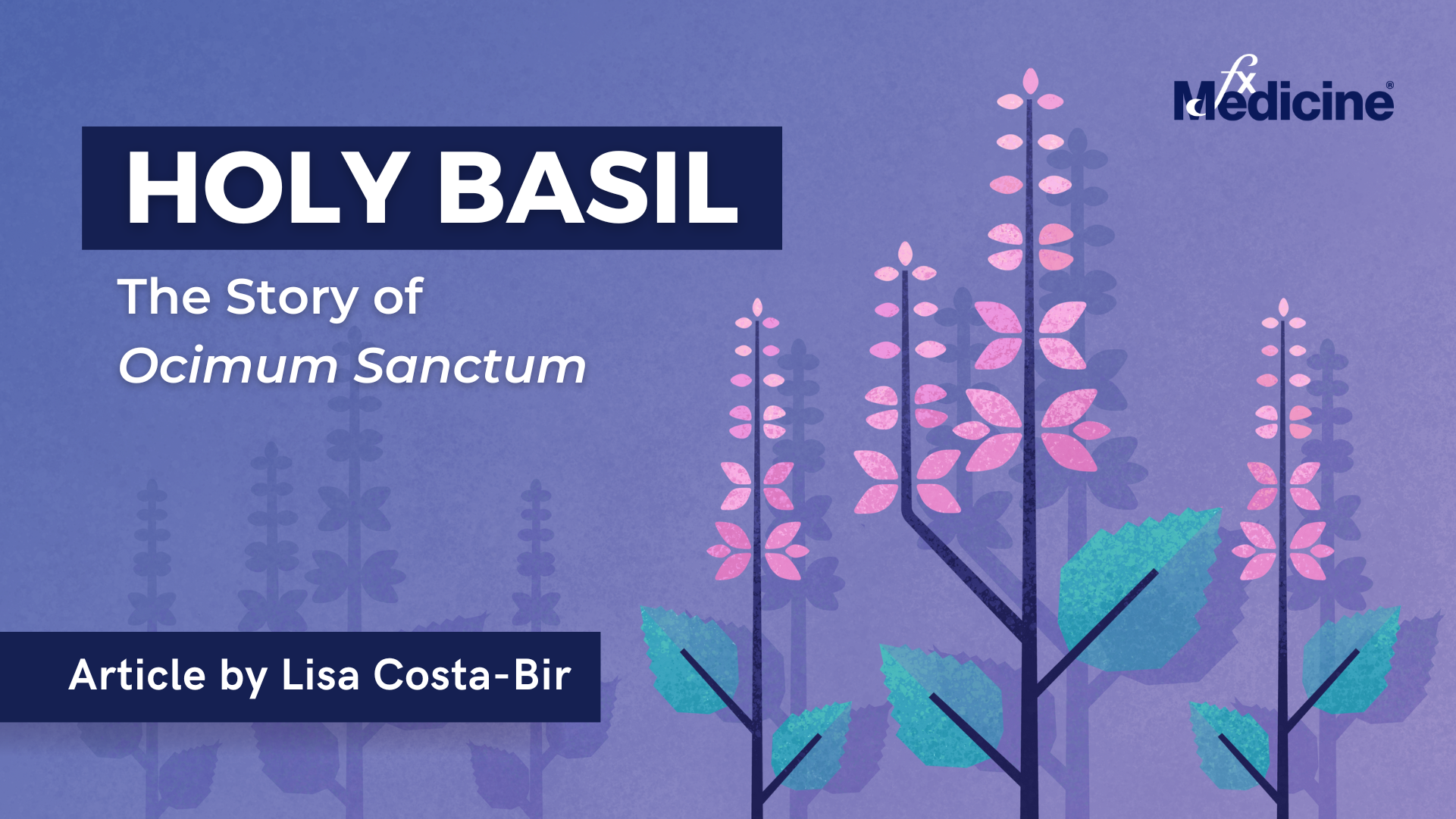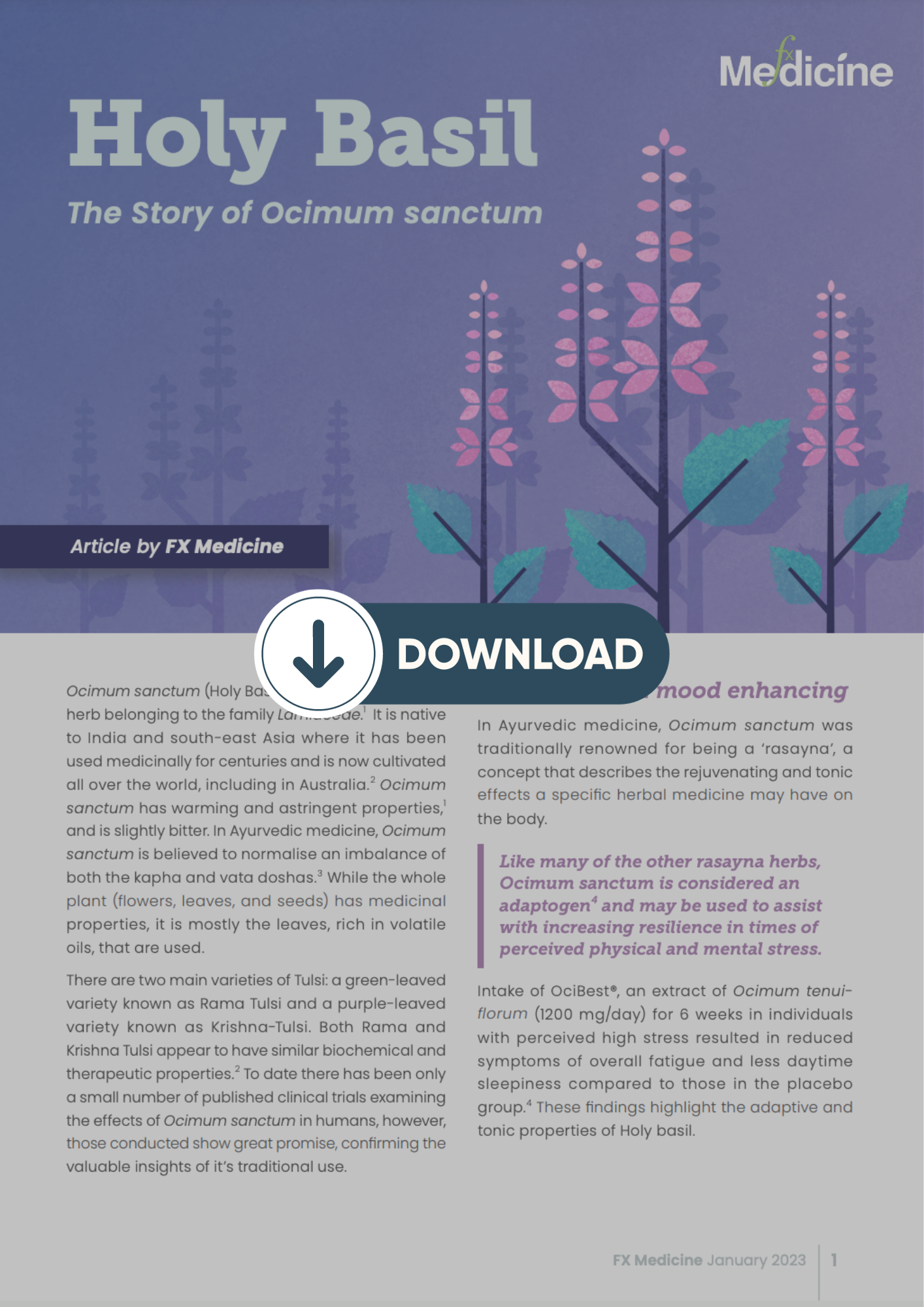Ocimum sanctum (Holy Basil or Tulsi) is an aromatic herb belonging to the family Lamiaceae.1 It is native to India and south-east Asia where it has been used medicinally for centuries and is now cultivated all over the world, including in Australia.2 Ocimum sanctum has warming and astringent properties,1 and is slightly bitter. In Ayurvedic medicine, Ocimum sanctum is believed to normalise an imbalance of both the kapha and vata doshas.3 While the whole plant (flowers, leaves, and seeds) has medicinal properties, it is mostly the leaves, rich in volatile oils, that are used.
There are two main varieties of Tulsi: a green-leaved variety known as Rama Tulsi and a purple-leaved variety known as Krishna-Tulsi. Both Rama and Krishna Tulsi appear to have similar biochemical and therapeutic properties.2 To date there has been only a small number of published clinical trials examining the effects of Ocimum sanctum in humans, however, those conducted show great promise, confirming the valuable insights of it’s traditional use.
Adaptogen and mood enhancing
In Ayurvedic medicine, Ocimum sanctum was traditionally renowned for being a ‘rasayna’, a concept that describes the rejuvenating and tonic effects a specific herbal medicine may have on the body. Like many of the other rasayna herbs, Ocimum sanctum is considered an adaptogen4 and may be used to assist with increasing resilience in times of perceived physical and mental stress.
Intake of OciBest®, an extract of Ocimum tenuiflorum (1200 mg/day) for 6 weeks in individuals with perceived high stress resulted in reduced symptoms of overall fatigue and less daytime sleepiness compared to those in the placebo group.4 These findings highlight the adaptive and tonic properties of Holy basil.
Similarly, in a small randomised controlled trial involving 35 participants with generalised anxiety disorder, Ocimum sanctum extract 500 mg consumed twice a day over 60 days improved mood and assisted with stress adaptation. Individuals were assessed clinically as well as via a self-reported questionnaire at three points over 60 days. As well as less depression and anxiety, participants reported better attention to detail, highlighting the cognitive enhancing properties of Ocimum sanctum, with researchers hypothesising that Ocimum sanctum may exert these effects via regulation of the hypothalamus-pituitary-adrenal (HPA) axis. A later study by Sampath et al. (2015)5 examining the effects of Ocimum sanctum on cognitive parameters in healthy volunteers over 30 days, noted that while there was a significant reduction in salivary cortisol concentrations, the results, while clinically significant, were not statistically significant when compared to the placebo group, suggesting a more complex mechanism of action at play.
Immune enhancing
A literature review examining the safety and efficacy of Ocimum sanctum in humans observed the ability of Ocimum sanctum to enhance immunity in five of the studies reviewed.6 One paper included in the review demonstrated that Ocimum sanctum reduced viral load in the saliva of individuals with herpes virus,6 highlighting its immune-enhancing properties.
Similar immune-enhancing effects were observed in a small randomised controlled trial in healthy adult participants after four weeks of consuming 300 mg/day of Ocimum sanctum leaf extract.7 Increased Natural Killer (NK) and T-helper cells were observed, reflecting an enhanced immune response. Chronic stress reduces the activity of NK cells, subsequently increasing vulnerability to infection.7
It can be hypothesised that prophylactic use of an herbal medicine like Ocimum sanctum may be helpful to assist with the increased psychological and immunological stress many individuals face in modern day life.7 While more rigorous studies with larger sample sizes and longer durations are required, Ocimum sanctum appears to be a safe herbal medicine with a long history of traditional use. It’s multifaceted properties as tonic, adaptogenic and immune enhancement make it an ideal choice for the modern-day dispensary to support clients needing assistance with immunity and resilience.
Download a pdf version of this article
References
1. Pattanayak P, Behera P, Das D, Panda SK. Ocimum sanctum Linn. A reservoir plant for therapeutic applications: An overview. Pharmacogn Rev. 2010;4(7):95-105. doi:10.4103/0973-7847.65323
2. Pandey V, Swami RK, Narula A. Harnessing the Potential of Roots of Traditional Power Plant: Ocimum. Front Plant Sci. 2021;12:765024. Published 2021 Nov 1. doi:10.3389/fpls.2021.765024
3. Cohen MM. Tulsi - Ocimum sanctum: A herb for all reasons. J Ayurveda Integr Med. 2014;5(4):251-259. doi:10.4103/0975-9476.146554
4. Saxena R. C., Singh R., Kumar P., et al. Efficacy of an extract of ocimum tenuiflorum (OciBest) in the management of general stress: A Double-blind, Placebo-controlled Study. Evidence-based Complementary and Alternative Medicine. 2012;2012:7. doi: 10.1155/2012/894509.894509
5. Sampath S, Mahapatra SC, Padhi MM, Sharma R, Talwar A. Holy basil (Ocimum sanctum Linn.) leaf extract enhances specific cognitive parameters in healthy adult volunteers: A placebo controlled study. Indian J Physiol Pharmacol. 2015 Jan-Mar;59(1):69-77. PMID: 26571987.
6. Jamshidi N, Cohen MM. The Clinical Efficacy and Safety of Tulsi in Humans: A Systematic Review of the Literature. Evid Based Complement Alternat Med. 2017;2017:9217567. doi:10.1155/2017/9217567
7. Mondal S., Varma S., Bamola V. D., et al. Double-blinded randomized controlled trial for immunomodulatory effects of Tulsi (Ocimum sanctum Linn.) leaf extract on healthy volunteers. Journal of Ethnopharmacology. 2011;136(3):452–456. doi: 10.1016/j.jep.2011.05.012.



